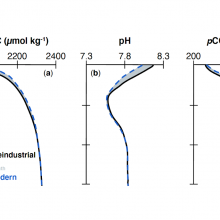New study shows larger human-released CO2 increases in subsurface waters of the North Pacific Ocean than in the atmosphere
Arroyo, M.C., A.J. Fassbender, B.R. Carter, C.A. Edwards, J. Fiechter, A. Norgaard, and R.A. Feely (2022): Dissimilar sensitivities of ocean acidification metrics to anthropogenic carbon accumulation in the Central North Pacific Ocean and California Current Large Marine Ecosystem. Geophys. Res. Lett., 49(15), e2022GL097835, doi: 10.1029/2022GL097835, View online (open access).
The ocean plays a key role in mitigating climate change by absorbing about 25 percent of the carbon dioxide gas (CO2) released into the atmosphere each year by human activities.

The modern ocean (blue dashed profiles) reflects the combination of natural, preindustrial conditions (black profiles) and human-induced changes (gray shading). (a) Dissolved inorganic carbon (DIC; µmol kg-1) has increased most near the surface where the ocean absorbs CO2 from the atmosphere. This has caused measurable and distinct changes in (b) pH and (c) pCO2 (µatm). Click on image to enlarge.


